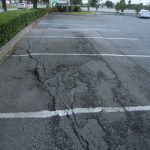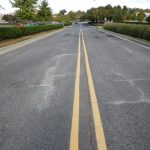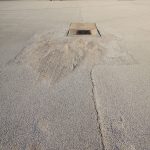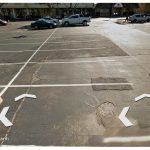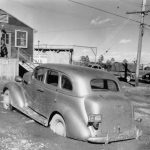We recently had a two-phase paving project providing a good example of paint performance on newly paved hot mix asphalt concrete. On the above photograph there is a seam between pavements paved 45 days apart with three spray paint applications. At the top is fresh paint only hours old. The […]
Tag Archives: Pavement Performance
Pavement Performance: Tree Roots
At mature shopping center properties, certain tree varieties will have root propagation between the pavement surface layer and the base course. If this is a one-off situation, our first solution is to surface mill the asphalt concrete layer and pave over the roots. This has a life of four to […]
We Keep Putting Stuff in Asphalt Concrete
There are two parts to the “holy grail” of asphalt concrete pavement performance: slow pavement cracking and reduce rutting caused by high truck traffic volumes. To this end, after modifying the aggregate blend, state highway departments and research universities seek additives to the simple mixtures of asphalt cement and well-graded […]
Pavement Performance: What is Going on Here?
From a cursory glance of the photograph, you could think mud had dropped from a pickup truck. An experienced engineer see that the light-colored markings are mineral fines (the powdery portion of crushed rock) being leeched out of the pavement structure by subsurface water pressure. The source could be, excess […]
Basic Concepts: Drainage
The typical pavement is a roadway – a long, relatively narrow strip of pavement which drains to structures along the curbs or out towards ditches. Water is not likely to remain on the pavement surface for long periods. Even water that gets into the pavement layer through cracks will flow […]
Basic Concepts: Heavy Vehicles
The typical parking lot is designed to carry light loads – passenger vehicles. There will be delivery trucks, garbage trucks, and maybe, buses. If your pavement has failures with cars passing over it, there are serious problems. Trucks and buses are a different matter. There was a rule of thumb […]
Basic Concepts: General Problems of Large Paved Areas
We design and try to build a uniform pavement structure (see above) to cover a site that is not homogeneous. Our most recent example of land resisting being covered happened after several days of heavy rainfall in south Texas. The photograph presents a five-year-old pavement which appears to have […]
Basic Concepts: Understanding Causes of Pavement Failures Saves Money
In the previous post, we discussion pavements have high initial construction cost and ongoing routine maintenance costs. At the end of the pavement’s performance life there will be a resurfacing or replacement cost. The in between cost, maintenance costs, can vary depend on the technique selected. An objective pavement distress […]
Basic Concepts: Pavement Ownership Costs Money
The greatest cost in the pavement lifecycle is the initial construction cost followed by future overlay or reconstruction costs. The surface type selection will determine the number of pavement layers and their thicknesses and the ultimate costs. In general, hot mix asphalt concrete will have lower initial costs in most […]
Basic Concepts: Pavement Performance Primer
Pavements keep us out of the mud Pavements keep us out of the mud This was mentioned in our first posts. There are a multitude of options to keep us clean and dry. What is the budget? What is the surface type, how many layers, and how thick are the […]

